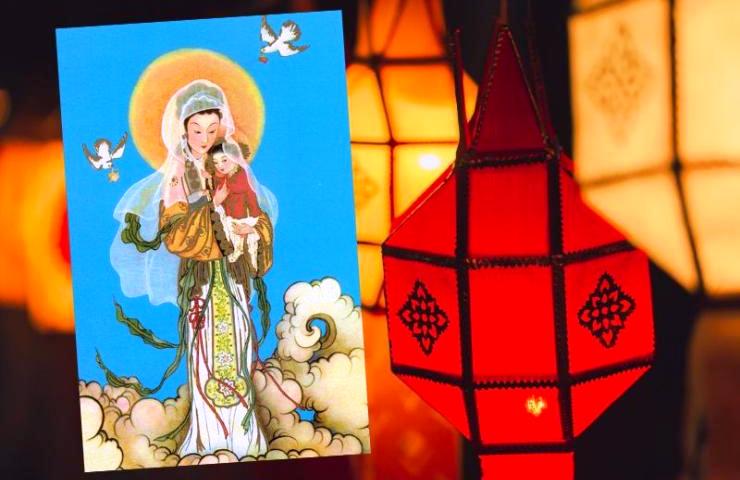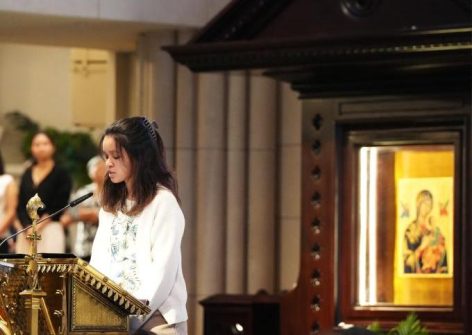The Asian Faces of Mary.

Non-Christians venerate Mary in Asia. Mary stands as an interreligious bridge that belongs to everyone. She is the most universal religious figure on the continent. Professor Michael Chamboni, coordinator of the Asian Catholic Studies Initiative, explains why.
At Novena church, the most famous church in Singapore, it is not uncommon to see Muslim and Hindu devotees bringing their petitions to Mary. These non-Catholic visitors come to this shrine of Our Lady of Perpetual Help for many reasons. Some visitors explain that when they were young, they went to a Catholic school and got in the habit of making vows to the Virgin. They pray according to their religious tradition but keep Mary in their own spiritual life. They do not want to convert to Christianity but value the figure of Mary.

Singapore. The Church of Saint Alphonsus, or Novena Church as it is more popularly known. (facebook)
Hindus and Muslim
Through the many places of pilgrimage, Mary can be found at the centre of the great inter-religious circuits of Asia. In India, for example, thousands of Hindu devotees go to Our Lady of Velankanni (Tamil Nadu), where Mary is said to have appeared in the 16th and 17th centuries, to pray and make vows.
Concerned with health, family, or work issues, these Hindu devotees join Catholic pilgrims to seek help from Mary. They make vows, promise material offerings, specific actions, and hope for progress. Ultimately, these Hindu devotees look after Mary’s capacity to improve things.

Basilica of Our Lady of Good Health in Velankanni, Tamil Nadu. It is known as the Lourdes of the East. CC BY-SA 4.0/ Matthew T Rader
This pan-religious nature of Marian devotions can challenge our understanding of religion. Modern people tend to believe that religions are coherent bodies of doctrines defined by a set of scriptures and a specific clergy. Religions are often presented as a system of beliefs and practices. But with the venerations of Mary by Hindu, Buddhist, and Taoist devotees, this supposedly universal definition of religion does not work. Religious practices do not always fit into predefined doctrines
and coherent systems.
Mary in the homes
Mary cannot be reduced to public worship sites. She is the most common religious figure in the domestic sphere. Her statues and images are commonly found inside the living rooms and bedrooms of numerous Asian people. Between the individual heart of people and their public sanctuaries and churches, there is their private home. This space is an essential realm of their religious life.
At home, Mary may escape from regulations promoted by state and religious authorities. This was the case with Maria Kannon in Edo Japan. Today, Jesuit Aristotle Dy reports that inside Chinese-Filipino houses that he visited, Mary can sometimes be found next to a statue of Guanyin. The two receive the same incense offering and are portrayed by her devotees as emanations of the same principle.

Maria Kannon in Edo Japan. Photo: Gemeinfrei/ Iwanafish
In other words, the predominance of Mary within the intimacy of the domestic sphere, where she can coexist with various religious traditions and practices, invites us to question our tendency to reduce religion to its public and compartmentalized display. Simply put, either at home or at public pilgrimage sites, Marian devotees are not easily reducible to their predefined religions. They assert their hopes and needs that are often shaped by religious languages, sociopolitical realities, and cultural habits. Challenging our preconceptions, people draw inspiration from different sources and traditions. For many, religious life is not limited to a system or a social belonging. It is also made of interpersonal relationships with a variety of other-worldly figures.
Subsequently, the variety of these Marian devotions invites us to also reconsider cross-religious hybridity and encounters. If Mary invites us to rethink religion, she also challenges many discourses on interreligious dialogue. In Singapore, India, and Vietnam, some political forces have long promoted an understanding of religions in which the risk for intercommunal violence is always highlighted.
In their eyes, religions make people highly emotional and irrational. Therefore, in highly diverse societies, the state must closely monitor religions and religious leaders to prevent interreligious violence. But this characterization of religions is also a way to reinforce the legitimacy of the state and its control over people. For instance, in Indonesia, interfaith marriages are made illegal by the state.
But pan-religious Marian devotions provide a different understanding of interreligious relations. First, we saw that religions cannot be reduced to predefined and mutually exclusive systems. Lived religions are more creative, mixed, and flexible. Second, Mary shows that faith practitioners can ignore established authorities and official doctrines to cross boundaries without killing each other. Pious people can generate a wide range of cross-religious devotions and pilgrimages to build forms of communion inside socio-religious diversity.
Mary as an interreligious bridge
Despite concerns for narrowly defined orthodoxy, Mary stands as an interreligious bridge that belongs to everyone.
Silently, she is a popular ally to build religious coexistence and prevent intercommunal violence. In practice, she offers an alternative to vertical control and condescendence.
Although the cross-religious nature of Marian devotions may raise legitimate concerns about syncretism, there is a lot to learn from it. The universality of Mary in Asia helps us to revisit the ways we understand religion, interreligious relations, and religious regulations.
Nevertheless, and this will be my final point, this cross-religious nature of Marian devotions may also help us to question our definition of Asian religions. What makes a religion Asian? How is Mary part of this Asianization and de-Asianization of religious traditions?

Mary stands as an interreligious bridge that belongs to everyone. (facebook)
In her book, “Race, Gender, and Religion in the Vietnamese Diaspora”, sociologist Thien-Huong Ninh presents the transformations that Our Lady of La Vang has gone through during the past few decades. This Marian devotion is based on an apparition of Mary in the late 18th century near the village of La Vang (central Vietnam). One intriguing aspect is that until the end of the 20th century, Our Lady of La Vang was represented through artistic features rooted in a European style. Mary looked like a Westerner.
In the late 1990s, however, Vietnamese bishops got inspired by Van Nhan Tran, a U.S.-based Vietnamese artist, and began to promote representations of Our Lady of La Vang wearing traditional Vietnamese outfits such as white traditional clothes (áo dài) and a golden headdress.
Soon, this Vietnamese version of Mary became extremely popular throughout the Vietnamese diaspora and in Vietnam. In the USA, she became the center of the largest Marian pilgrimage in the country. In October 2023, a shrine of our Lady of La Vang was even inaugurated near Fatima, Portugal.

Vietnam. Our Lady of La Vang. (facebook)
Our Lady of La Vang
For some Vietnamese, this version of Our Lady of La Vang is a matter of national pride. Meanwhile, for others, it is a symbol of the harmonious diversity that Catholicism supposedly represents. Her worldwide popularity relates to different political contexts, migratory patterns, and international imaginaries. But Our Lady of La Vang also illustrates the constant remaking of Catholicism as an Asian religion. Despite modern prejudices, the papal religion has long been and continues to recast itself as a religion of Asia. In this process, Mary is an important factor to consider. In conclusion, Marian devotions deserve more than intellectual disdain, pious blindness, or doctrinal reinforcement. If they challenge various ideologies and doctrines, they also remind us that devotional practices are well alive, owned by all, and able to address all sorts of hopes, concerns, and needs.
Despite our necessary dogma, Mary is not easy to capture. Despite our comforting devotions, she is never as immaculate as one may assume. Despite a certain modern push to either marginalize or idealize her role within Christianity, her popularity forces us to re-envision her exact significance.
Asian devotions highlight her centrality to the dialogue that Asian people cultivate with Christian and non-Christian traditions. Mary in Asia remains an intriguing question taking us beyond our comfort zone. With her colorful devotees, she is a challenging figure who invites us to reconsider our religious position and the ways we conceptualize religion, Catholicism, and interfaith dialogue.



